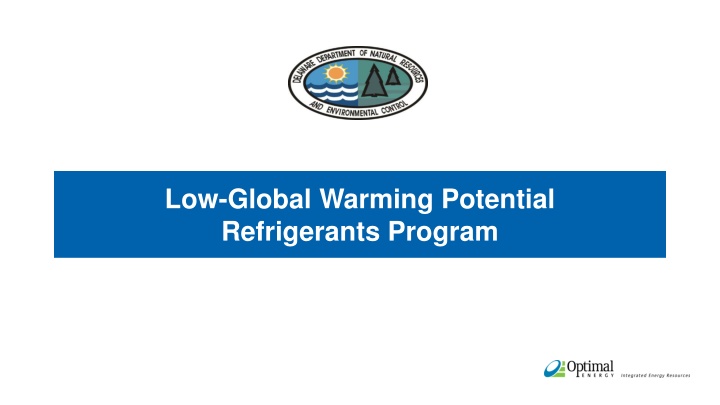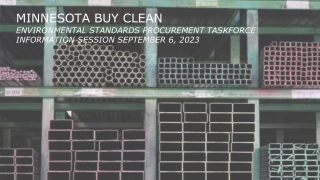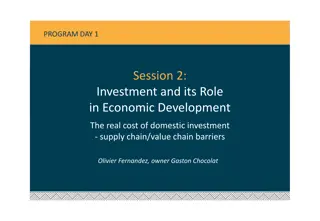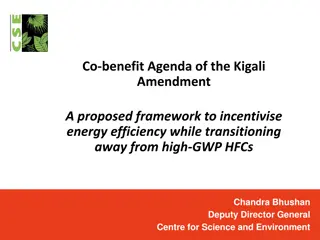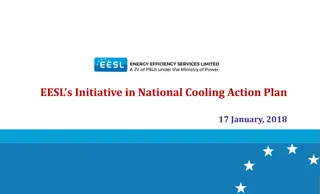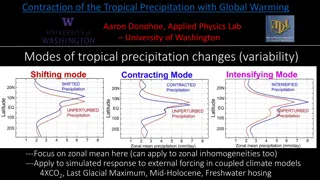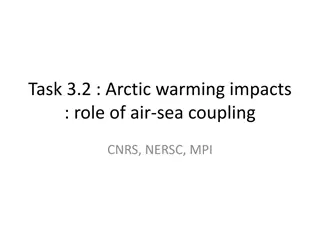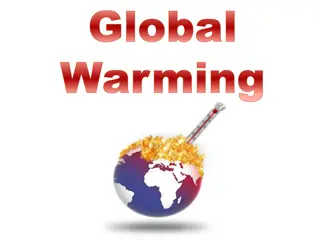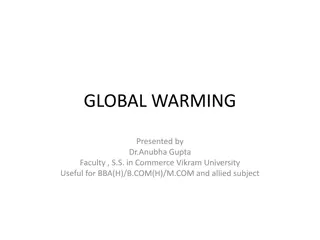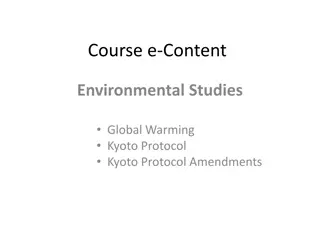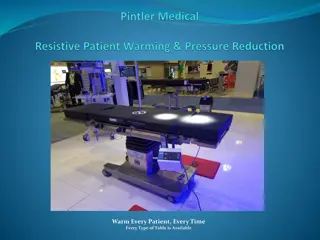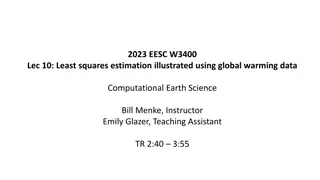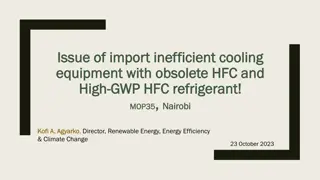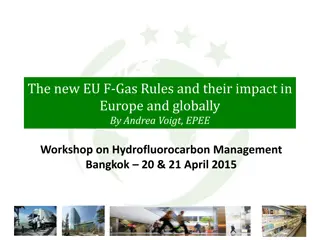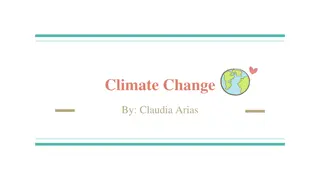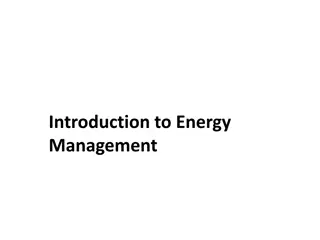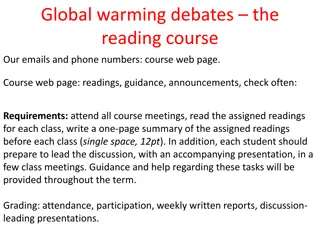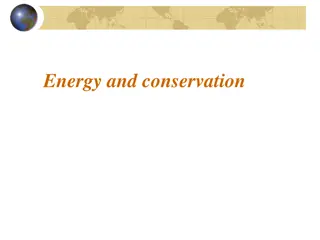Advancing Low-Global Warming Potential Refrigerants Program
Refrigerants play a vital role in heating and cooling systems, but some chemicals contribute to global warming. The Low-Global Warming Potential Refrigerants Program aims to promote the use of environmentally friendly refrigerants with a lower global warming impact. Delaware has an opportunity to lead in this area by implementing incentives and engaging with the workforce to establish a successful program.
Uploaded on Sep 25, 2024 | 4 Views
Download Presentation

Please find below an Image/Link to download the presentation.
The content on the website is provided AS IS for your information and personal use only. It may not be sold, licensed, or shared on other websites without obtaining consent from the author.If you encounter any issues during the download, it is possible that the publisher has removed the file from their server.
You are allowed to download the files provided on this website for personal or commercial use, subject to the condition that they are used lawfully. All files are the property of their respective owners.
The content on the website is provided AS IS for your information and personal use only. It may not be sold, licensed, or shared on other websites without obtaining consent from the author.
E N D
Presentation Transcript
Low-Global Warming Potential Refrigerants Program
Refrigerants and Environmental Impact Refrigerant systems use manufactured chemicals designed to efficiently move heat In the 1980s, it was discovered that some of these chemicals severely damage the ozone layer So, they were banned by international treaty (1987 Montreal Protocol) It has more recently been discovered that some of the new, replacement chemicals contribute a considerable amount to global warming per pound of emissions. For example: 1 pound of R410A = 2088 lbs. of carbon dioxide 1 pound of Ammonia = 0 Global Warming Potential (GWP) This program s goal is to recognize this fact, and incentivize use of refrigerant chemicals that that have less Global Warming Potential (GWP) impact. 2
An Industry-Leading Opportunity for Delaware Global warming impacts from refrigerants have received limited attention in U.S. federal and state policy up to now We were only able to find municipal- level programs, such as the Sacramento Municipal Utility District (SMUD) program Delaware could be a national leader in this area To pursue this opportunity, more on- the-ground experience is needed, so we can evaluate it and incorporate into our analysis 3
Next Steps for Establishing a DE GWP Program Set Program Incentives Engage with Delaware Workforce Delaware Market Research Verify Leak Rates e.g. require monitoring equipment if incentive received 5
Set Program Incentives Set Program Incentives Finalize list of eligible low GWP refrigerants Set payment per ton-CO2 equivalent avoided & incentive caps 6
Set Program Incentives Project Incentive Cap Total $ vs. % of project cost Incentive per ton avoided CO2-e Our analysis so far has assumed $25/tCO2e, based on the SMUD program We suggest starting with a total $ cap only, of $100,000. We believe this is a good starting point, and the program should be launched using this incentive level With the $680,000 budget based on our analysis, the program can provide incentives to at minimum ~7 projects If program uptake starts off slow, this figure can be raised An aggressive incentive, $100/tCO2e, is the value used in RI cost-benefit tests. If popular, adding a secondary cap requiring matching funds makes sense Re-assess every 3-6 months in first two program years, and then annually 7
Engage with Workforce Engage with Workforce Understand familiarity with low-GWP refrigerant systems Determine level of workforce training needed 8
Engage with Workforce Low-GWP refrigerant familiarity April develop interview guide for workforce research Training & Outreach Plan July If needed, allocate $100,000 from program year 1 budget to training & outreach. Develop training material. May phone-based outreach to 10-20 refrigeration system servicing firms June synthesize findings into a perspective on level of familiarity, and level of comfort installing low-GWP systems August Finish development of training materials, make them available online September + beyond Provide quarterly training webinar/seminar with outreach to industry groups to drive awareness 9
Delaware Market Research Quantify current refrigerant mix in use in Delaware Assess level of interest in low-GWP refrigerant incentives 10
Delaware Market Research Large Firm Outreach April Build list of largest refrigerant systems in DE (~10-25 total) Survey for Interest April/May Develop online/phone survey to gather information from small businesses about refrigeration systems (current and low-GWP interest) May Directly contact each facility to understand current refrigerant system and, if not already low-GWP, interest level in June/July Use this survey instrument to gather a statistically significant sample of refrigerant systems and owners interests in low- GWP alternatives June Synthesize findings, adjust estimate of annual program throughput & budget if needed 11
Refrigerant System Retrofit Costs Model One area with limited information is the full costs of retrofitting to low-GWP refrigerants Many potential customers will also lack this information DNREC can help remove this barrier by gathering information from manufacturers, contractors, and other geographies where these systems are more common 12
Verify Leak Rates Program will initially launch using deemed savings based on past refrigerant recharge purchases, and low-GWP leak data from manufacturers Once systems that received incentive $$ come online: Tracking actual system leak rates can be used to refine deemed savings algorithm, or to begin paying incentives based on actual leakage 13
Delaware 2019 HFC Program Development Schedule Phone-based outreach to 10-20 refrigeration system servicing firms Synthesize findings into a perspective on level of familiarity, and level of comfort installing low- GWP systems Develop interview guide for workforce research If needed, allocate $100,000 from program year 1 budget to training & outreach. Develop training material. Finish development of training materials, make them available online Program Start Directly contact each facility to understand current refrigerant system and, if not already low-GWP, interest level in Build list of largest refrigerant systems in DE (~10-25 total) Provide quarterly training webinar/seminar with outreach to industry groups to drive awareness Synthesize findings, adjust estimate of annual program throughput & budget if needed Develop online/phone survey to gather information from small businesses about refrigeration systems (current and low-GWP interest) Use survey instrument to gather a statistically significant sample of refrigerant systems and owners interests in low-GWP alternatives Jun Aug Jul May Launch Program Gather further information about market potential, customer and contractor interest and awareness, typical installation costs Update estimated funding need, program potential Provide Training Materials and Sessions Allocate funding to training and outreach, if needed Create Mgmt. plan for beyond 2019 14
Questions? 15
